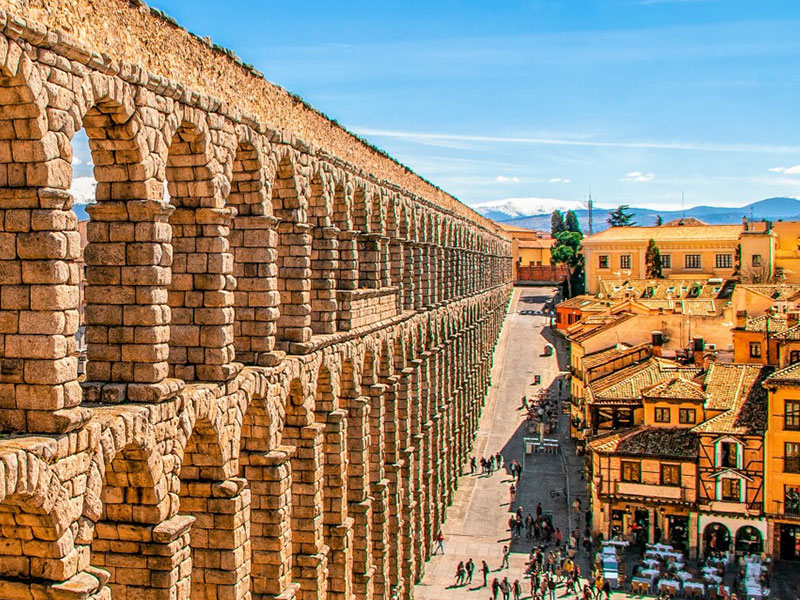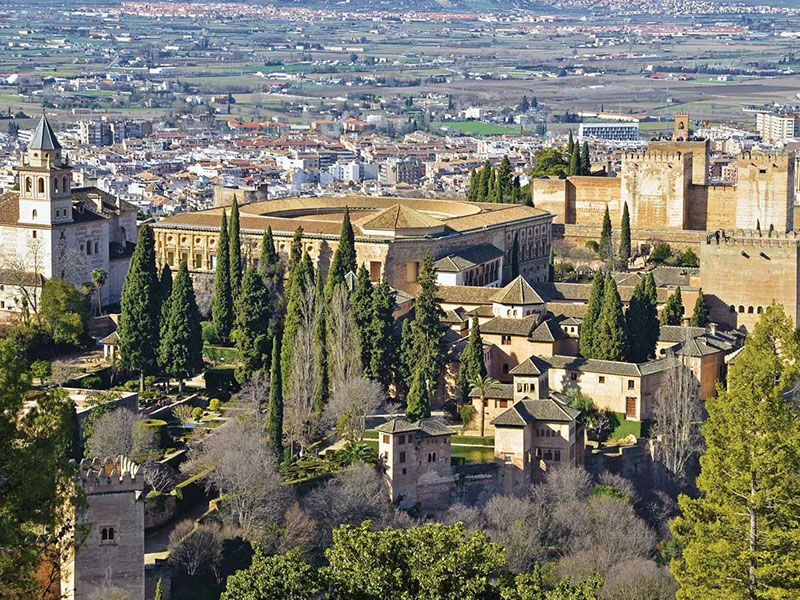
وبلاگ سپهران | Countries | History of Spain
History of Spain, land of sunset
The country of Spain is an independent semi-peninsular nation located in southwestern Europe. It shares its borders with the Mediterranean Sea and Gibraltar to the south and east, France and the north and northeast, and Portugal and the Atlantic Ocean to the west and northwest.
In addition to this mainland area, Spain’s territory includes islands such as the Balearic Islands in the Mediterranean Sea, the Canary Islands off the African coast in the Atlantic Ocean. In total, its territory covers an area of over 505,992 square kilometers, making it the fifth-largest country in Europe in terms of land area.
Follow Sepahran’s blog.
The etymology of the name Spain is derived from the Roman title “Hispania,” which means “Land of the West” or “Land of the Setting Sun.”
Other suggested meanings for this word include “Island of the Rabbits,” “Land of Rabbits,” “Edge,” or “Border,” all of which in some way relate to the culture, history, and geography of Spain.
The history of settlement in this country dates back to approximately 35,000 years ago when peoples from various civilizations, including Iberians, Basques, and Celts, settled in different regions of the land.
Until around 200 BCE, much of the population on this peninsula lived as independent tribes until the Roman Empire eventually conquered the coastal Mediterranean regions through the Punic Wars.
The Roman occupation of the entire Iberian Peninsula was not easy, and various Roman emperors made extensive efforts in this regard until, ultimately, they succeeded in taking control of the land after two centuries of struggle. In the early 5th century CE, the gradual disintegration of the Roman Empire in Hispania began, and in a short period, Suebi tribes managed to gain control over their dominions.
With the spread of Islam and the movement of Muslims into Europe, the Moors, who were North African Muslims, managed the entire peninsula, except for a small portion of the northwestern mountainous regions, by the 8th century. They also officially recognized Christianity and Judaism, creating conditions for the gradual expansion of Islam’s influence to the extent. So, by the end of the 10th century, Muslims made up the majority of the population on this semi-peninsula.
This integrated process was supposed to lead to social and political stability, but contrary to this theory, Islamic society experienced social tensions. North African Berbers, as the core of the caliph’s army in Al-Andalus (Spain), clashed with Arab leaders in the Middle East and engaged in strife and rivalry. As a result, independent Muslim communities of the Moors were formed in various parts of the semi-peninsula.
These separate emirates led to Christian small states gradually expanding their territories during the 11th century. So, eventually forming a union of Christian states that confronted the Moors. Eventually, in the second half of the 15th century, they defeated the Moors. Therefore conquered the Canary Islands, and united the kingdoms of Castile and Aragon through the marriage of Queen Isabella and King Ferdinand, establishing a joint empire of the two crowns. Despite this unity, they continued to exist as two separate kingdoms with distinct political systems.

Isabella became the queen of the new empire and took numerous actions to expand Spain’s power and influence. In the first step, she sponsored Christopher Columbus on an exploratory voyage that ultimately led to the discovery of the continent of America. On the other hand, by establishing the Spanish Inquisition and enacting strict Christian laws, efforts were made to force Jews and Muslims to convert to Catholicism. As a result of such pressures, a significant portion of believers in other religions were forced to leave Spain.
With the conquest of Navarre by King Ferdinand in 1512, the process of centralizing power on the peninsula was completed, resulting in the formation of the main borders of present-day Spain. As a result, this country quickly became one of the most powerful nations in Europe and the world during the 16th and 17th centuries, especially during the reigns of Charles I (1516-1556 CE) and Philip II (1556-1598 CE) of the Habsburg dynasty. They also acquired a large part of the American continent, islands in the Asia-Pacific region, cities in North Africa, and vast regions of Europe (including France, Germany, Belgium, Luxembourg, Italy, and the current Netherlands).
The continuous growth of the empire’s colonies and the exploitation of the natural resources of these lands, coupled with the religious policies imposed by the central government, the rise and formation of the Ottoman Islamic Empire, endless conflicts within the vast territory, the spread of diseases, and more, were all factors contributing to the weakening of the empire.
This ultimately led to independence movements, which, after three decades of bloodshed in European history, confronted Spain with the challenge of preserving stability, power, and security in the second half of the 17th century. In such a situation, movements for freedom succeeded in breaking away from parts of the empire’s territory in the European continent.
On the other hand, the increasing competition and rivalry among the royal dynasties for the acquisition of power, which resulted in internal wars, ultimately led to Spain’s decline in the early 18th century, followed by the heavy cost of the downfall of one of the world’s greatest known empires. The end point of its Andalusian glory should be attributed to the Bourbon dynasty’s rise to power, which, with French origins, took control of Spain.
This was the result of Spain’s involvement in a war against the French revolutionaries that led to her defeat and, ultimately, the rise to power of Joseph Napoleon Bonaparte, the brother of Napoleon Bonaparte.

History of Spain
The erosion of Spanish national pride due to such developments led to multiple revolutionary uprisings that ultimately culminated in a bloody war. In most cases, the victory favored the forces of the French Emperor. This process continued until, as a result of the Russian campaign, Napoleon was forced to withdraw his troops from Spain. Ferdinand VII was able to return to power amidst the instability and political turmoil caused by the Napoleonic wars. As a consequence, aside from Cuba and Puerto Rico, the remaining Spanish colonies in the Americas, including the Philippines through independence movements, became free.
On the other hand, Spain’s role in Africa had become greatly diminished on the cusp of the 20th century, with only small portions of this vast continent remaining under its influence. Even in these cases, the central government consistently grappled with rebellions and independence movements.
Furthermore, with the establishment of the Second Republic at the end of the premiership of General Miguel Primo de Rivera, the regions of the Basque Country, Catalonia, and Galicia gained autonomy. Far-left extremists, insistent on this issue, instigated rebellions that led to another civil war in the country. This war began on July 17, 1936, and lasted for three years. Ultimately, it concluded with the bloody victory of Francisco Franco, who was supported by Nazi Germany and Fascist Italy.
The rise of fascist Spain coincided with the start of World War II. Although Spain declared its neutrality in the conflict, it was, in reality, a defender and supporter of the Axis powers led by Nazi Germany in this global struggle. As a result, after World War II, Spain withdrew into political and economic isolation and couldn’t gain membership in the United Nations until 1955.
The primary reason for the sudden shift in global attention towards Spain was its strategic importance during the height of the Cold War, facing off against the Soviet Union. This factor contributed to Spain’s unprecedented economic growth and prosperity.
With the death of Franco in November 1975, Juan Carlos I assumed the role of constitutional monarch of Spain and succeeded him as head of state. To expedite the process of reform, he removed Carlos Arias Navarro, who had served as prime minister during Franco’s era, and appointed Adolfo Suárez as his successor. Under the new constitution adopted in 1978 and in the pursuit of establishing democracy, the central government decentralized power in favor of autonomous regions and provinces. Since then, although Spain still grapples with separatist movements in some regions like Gibraltar, the Canary Islands, Ceuta, Melilla, the Balearic Islands, and the city of Olivenza, it has enjoyed relative political and economic stability. Despite occasional territorial disputes with some countries, Spain remains a respected and influential global player.